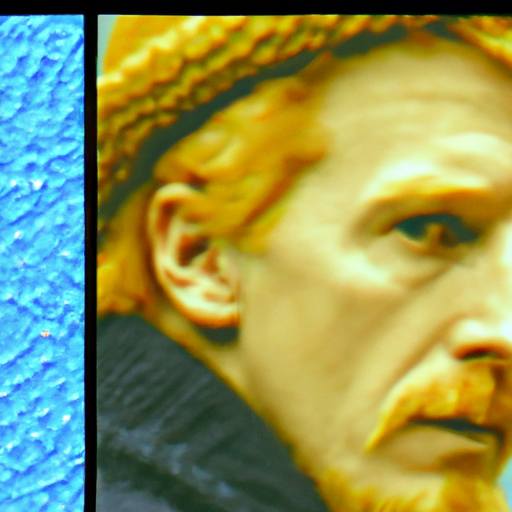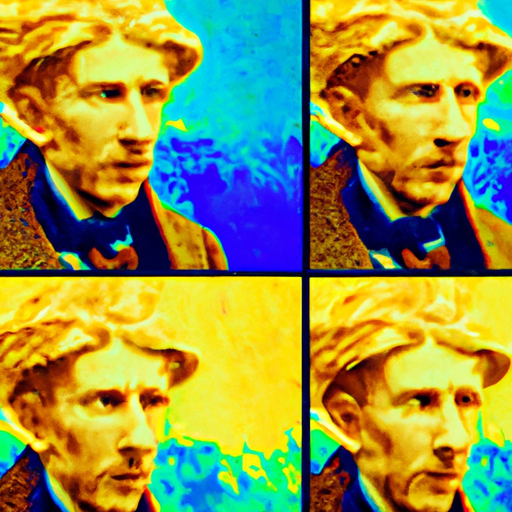
-
Table of Contents
Vincent van Gogh’s Use of Color and Texture in Design

Vincent van Gogh, a Dutch post-impressionist painter, is renowned for his unique and vibrant use of color and texture in his artworks. His innovative techniques and bold choices have had a profound impact on the world of art and design. In this article, we will explore how van Gogh’s use of color and texture revolutionized the field of design and continues to inspire artists and designers today.
The Power of Color
Van Gogh believed that color had the ability to evoke emotions and convey meaning. He used color as a tool to express his innermost thoughts and feelings, creating a visual language that resonated with viewers. One of the most striking aspects of van Gogh’s use of color is his bold and intense palette. He often used vibrant and contrasting colors to create a sense of energy and movement in his paintings.
For example, in his famous painting “Starry Night,” van Gogh used a combination of blues, yellows, and whites to depict the night sky. The swirling brushstrokes and vibrant colors create a sense of dynamism and evoke a feeling of awe and wonder. The use of complementary colors, such as the contrast between the warm yellows and cool blues, adds depth and visual interest to the painting.
Case Study: “Sunflowers”
Another iconic example of van Gogh’s use of color is his series of paintings featuring sunflowers. In these works, van Gogh used a range of yellows, oranges, and browns to depict the sunflowers. The intense and vibrant colors create a sense of vitality and joy, capturing the essence of the flowers. Van Gogh’s use of color in these paintings is not only visually striking but also conveys a deeper emotional meaning.
Van Gogh’s use of color was not limited to representing the physical appearance of objects but also served to express his emotions and inner turmoil. In his self-portraits, for instance, he often used bold and contrasting colors to convey his psychological state. The use of vibrant reds and greens in his self-portrait “Self-Portrait with Bandaged Ear” reflects his emotional turmoil and the pain he experienced during that period.
The Texture Revolution
In addition to his use of color, van Gogh’s innovative approach to texture revolutionized the field of design. He believed that texture could enhance the emotional impact of a painting and create a more immersive experience for the viewer. Van Gogh achieved texture in his paintings through his distinctive brushwork and layering techniques.
Van Gogh’s brushwork was characterized by bold and expressive strokes, often applied with thick layers of paint. This technique created a sense of depth and dimension, giving his paintings a tactile quality. The visible brushstrokes added texture to the surface of the canvas, making the paintings come alive.
Case Study: “The Starry Night”
“The Starry Night” is a prime example of van Gogh’s use of texture. The swirling brushstrokes and thick layers of paint create a sense of movement and energy in the painting. The texture adds a three-dimensional quality to the artwork, making it feel almost sculptural. The combination of color and texture in “The Starry Night” results in a visually captivating and emotionally evocative piece.
Van Gogh’s use of texture was not limited to his brushwork alone. He also experimented with other materials to add texture to his paintings. In “Wheat Field with Cypresses,” for instance, he used a palette knife to create texture in the fields of wheat and the bark of the cypress trees. This technique added a tactile quality to the painting, enhancing the viewer’s experience.
Inspiring Modern Design
Van Gogh’s use of color and texture continues to inspire modern design in various fields, including graphic design, interior design, and fashion. His bold and vibrant color palettes have influenced countless designers, who seek to create visually striking and emotionally engaging designs.
In graphic design, van Gogh’s use of color and texture can be seen in the work of contemporary designers who incorporate bold and contrasting colors to create impactful visuals. The use of texture, whether through digital techniques or physical materials, adds depth and visual interest to designs, just as van Gogh did in his paintings.
In interior design, van Gogh’s use of color and texture can be seen in the trend of incorporating vibrant and contrasting colors in home decor. The use of textured materials, such as textured wallpapers or fabrics, adds a tactile element to interior spaces, creating a sense of warmth and visual appeal.
In fashion, van Gogh’s use of color and texture has inspired designers to experiment with bold and vibrant color combinations. The use of textured fabrics, such as jacquard or brocade, adds depth and visual interest to garments, creating a unique and eye-catching look.
Summary
Vincent van Gogh’s use of color and texture in design revolutionized the field of art and continues to inspire artists and designers today. His bold and vibrant color palettes, combined with his innovative approach to texture, created visually captivating and emotionally evocative artworks. Van Gogh’s use of color and texture goes beyond mere representation, serving as a means to express his innermost thoughts and feelings. His influence can be seen in various design fields, from graphic design to interior design and fashion. The power of color and texture in design is undeniable, and van Gogh’s legacy serves as a constant reminder of their transformative potential.
